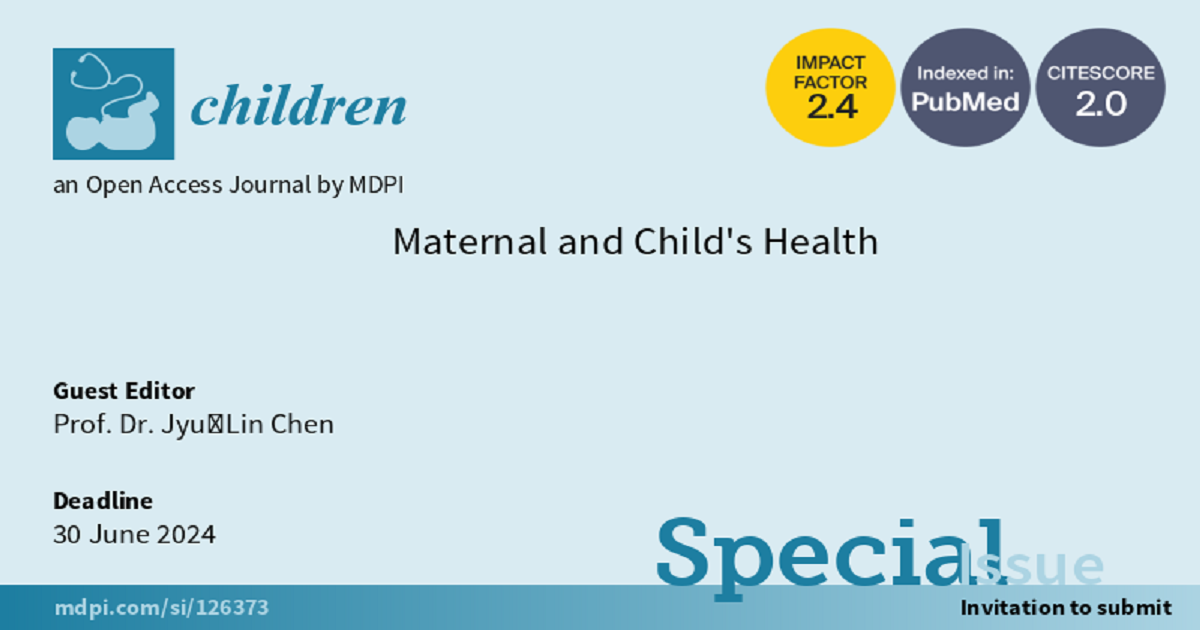Maternal and Child's Health
A special issue of Children (ISSN 2227-9067). This special issue belongs to the section "Global Pediatric Health".
Deadline for manuscript submissions: 31 December 2024 | Viewed by 26864

Special Issue Editor
Special Issue Information
Dear Colleagues,
Maternal health is key to improving the health of children. Parents, especially mothers, play an important role in guiding children and adolescents towards utilizing healthcare services and improving health. Women have always been influential in their family's healthcare decisions. For example, over three-quarters of mothers are responsible for choosing their children's provider, taking their children to appointments, and consenting to receive recommended care (Kaiser, 2018). In contrast, only one-fifth of fathers have been reported to complete the same tasks (Kaiser, 2018). Several studies have provided some insight into the impact of maternal health on children. For instance, studies have found that maternal physical and psychological health issues are associated with a high risk of physical and behavioral health issues in children (Logan et al., 2016; Rahman et al., 1993; Totskka et al., 2013). Improving the well-being of mothers is an essential factor in healthy children and families. This Special Issue calls for papers examining women's health and interventions that include mothers.
The goal of this Special Issue is to discuss maternal health and any aspects of children's health influenced by the mother, who plays an essential role during the development of her children. We hope to enhance the global understanding of these conditions by sharing knowledge about controversial areas in this field that are thus far incompletely understood.
We invite all colleagues researching topics related to the health of mothers and children to participate in this Special Issue.
Prof. Dr. Jyu‐Lin Chen
Guest Editor
Manuscript Submission Information
Manuscripts should be submitted online at www.mdpi.com by registering and logging in to this website. Once you are registered, click here to go to the submission form. Manuscripts can be submitted until the deadline. All submissions that pass pre-check are peer-reviewed. Accepted papers will be published continuously in the journal (as soon as accepted) and will be listed together on the special issue website. Research articles, review articles as well as short communications are invited. For planned papers, a title and short abstract (about 100 words) can be sent to the Editorial Office for announcement on this website.
Submitted manuscripts should not have been published previously, nor be under consideration for publication elsewhere (except conference proceedings papers). All manuscripts are thoroughly refereed through a single-blind peer-review process. A guide for authors and other relevant information for submission of manuscripts is available on the Instructions for Authors page. Children is an international peer-reviewed open access monthly journal published by MDPI.
Please visit the Instructions for Authors page before submitting a manuscript. The Article Processing Charge (APC) for publication in this open access journal is 2400 CHF (Swiss Francs). Submitted papers should be well formatted and use good English. Authors may use MDPI's English editing service prior to publication or during author revisions.
Keywords
- maternal and child health
- maternal health
- service and outcomes
- physical health
- behavior health
- maternal-health-focused interventions
- risk perceptions
- child obesity
- pregnancy
- health promotion
- disease prevention
Benefits of Publishing in a Special Issue
- Ease of navigation: Grouping papers by topic helps scholars navigate broad scope journals more efficiently.
- Greater discoverability: Special Issues support the reach and impact of scientific research. Articles in Special Issues are more discoverable and cited more frequently.
- Expansion of research network: Special Issues facilitate connections among authors, fostering scientific collaborations.
- External promotion: Articles in Special Issues are often promoted through the journal's social media, increasing their visibility.
- e-Book format: Special Issues with more than 10 articles can be published as dedicated e-books, ensuring wide and rapid dissemination.
Further information on MDPI's Special Issue polices can be found here.






